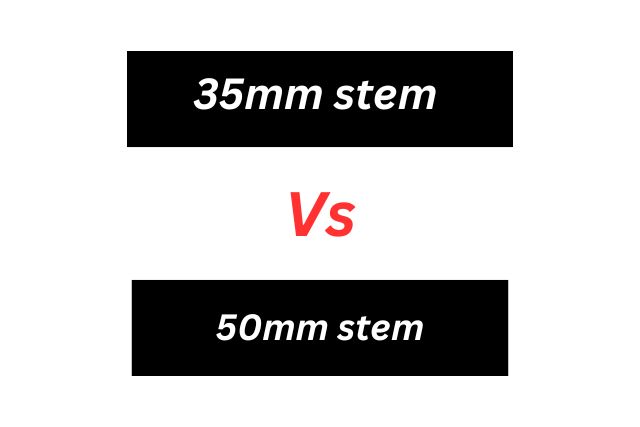
Choosing the right stem length for your bike can have a significant impact on your riding experience, comfort and performance. Stem length affects both your bike’s handling and your body position on the bike.
Below, we will compare two common stem lengths: 35mm and 50mm, and discuss their advantages and disadvantages for different types of riding.
What is a stem and why does it matter?
A stem is the component that connects your handlebar to your fork steerer tube. It holds the steerer tube in place in the headset and clamps the handlebar with a faceplate. A stem is usually made of aluminium or carbon fibre, though titanium is sometimes used.
The length of a stem is measured from the centre of the steerer tube clamp to the centre of the handlebar clamp. The length of a stem can vary from as short as 25mm to as long as 150mm, depending on the bike type and rider preference.
Stem length matters because it influences how your bike handles and how you fit on your bike. A shorter stem will result in faster, more responsive steering, while a longer stem will result in slower, more stable steering. A shorter stem will also bring you closer to the handlebar, creating a more upright position, while a longer stem will stretch you out, creating a more aerodynamic position.
35mm vs. 50mm Stem: Pros and Cons
35mm and 50mm are two popular stem lengths for mountain bikes, especially for trail, enduro and downhill riding. They are also becoming more common on gravel bikes, as riders seek more control and comfort on rough terrain.
Here are some of the pros and cons of each stem length:
35mm stem pros
More direct steering: A shorter stem will make your steering more responsive and agile, especially on tight turns and switchbacks. This can help you navigate technical terrain more easily and confidently.
More stability at speed: A shorter stem will also make your bike more stable at high speeds, especially when paired with a wide handlebar (around 780mm or more). This can help you maintain control and balance on rough sections and descents.
More comfort: A shorter stem will bring you closer to the handlebar, creating a more upright position that can reduce strain on your neck, back and wrists. This can improve your comfort and endurance on long rides.
35mm stem cons
Less weight distribution: A shorter stem will shift more of your weight to the rear of the bike, which can reduce the traction and grip of your front wheel. This can make it harder to weight the front wheel enough to corner effectively and prevent understeer or washouts.
Less aerodynamics: A shorter stem will also create a more upright position that can increase your wind resistance and drag. This can reduce your speed and efficiency on flat or uphill sections.
Read Also: 11-42 vs. 11-46 Cassette: Compared
50mm stem pros
More weight distribution: A longer stem will shift more of your weight to the front of the bike, which can increase the traction and grip of your front wheel. This can make it easier to weight the front wheel enough to corner effectively and prevent understeer or washouts.
More aerodynamics: A longer stem will also create a more stretched-out position that can decrease your wind resistance and drag. This can increase your speed and efficiency on flat or uphill sections.
50mm stem cons
Less direct steering: A longer stem will make your steering slower and less responsive, especially on tight turns and switchbacks. This can make it harder to navigate technical terrain quickly and confidently.
Less stability at speed: A longer stem will also make your bike less stable at high speeds, especially when paired with a narrow handlebar (around 700mm or less). This can make it harder to maintain control and balance on rough sections and descents.
Less comfort: A longer stem will stretch you out, creating a more aerodynamic position that can increase strain on your neck, back and wrists. This can reduce your comfort and endurance on long rides.
How to choose the best stem length for you?
There is no definitive answer to what is the best stem length for you, as it depends on various factors such as your bike’s geometry, your riding style, your personal preference and your body measurements.
However, here are some general guidelines to help you choose:
Bike’s Geometry
Different bikes have different geometries that affect how they handle and fit.
For example, a bike with a slacker head tube angle (around 65 degrees or less) will have a longer reach (the horizontal distance from the centre of the bottom bracket to the top of the head tube) than a bike with a steeper head tube angle (around 70 degrees or more). A longer reach will make your bike more stable, but also stretch you out more.
A shorter stem can help you compensate for a longer reach and bring you closer to the handlebar, while a longer stem can help you compensate for a shorter reach and stretch you out more.
Riding Style
Different riding styles require different levels of steering responsiveness, stability, aerodynamics and comfort.
For example, if you ride mostly on technical terrain that requires quick and precise steering, you may prefer a shorter stem that gives you more control and agility.
If you ride mostly on flat or uphill terrain that requires speed and efficiency, you may prefer a longer stem that gives you more aerodynamics and leverage.
If you ride a mix of terrain, you may prefer a medium-length stem that gives you a balance of both.
Personal Preference
The best stem length for you is the one that feels the most comfortable and natural for you. Some riders may prefer a shorter or longer stem than others, even if they ride the same bike and style.
The best way to find out what works for you is to try different stem lengths and see how they affect your bike’s handling and your body position.
You can also use online calculators or consult a bike fit expert to get an estimate of your ideal stem length based on your body measurements.
Read Also: Crankbrothers M19 vs. M20: Compared
Conclusion
Stem length is an important factor to consider when setting up your bike, as it can affect your bike’s handling and your body position. 35mm and 50mm are two common stem lengths for mountain bikes and gravel bikes, each with their own pros and cons.
The best stem length for you depends on your bike’s geometry, your riding style, your personal preference and your body measurements. The best way to find out what works for you is to try different stem lengths and see how they feel.
